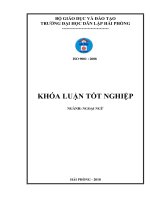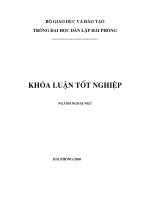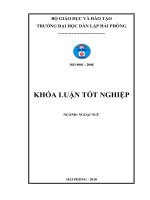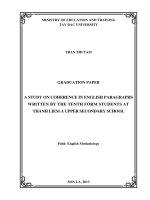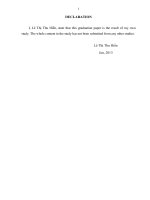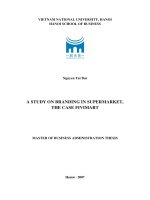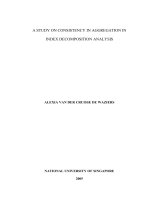A STUDY ON MODALITY IN ENGLISH-MEDIUM RESEARCH ARTICLES
Bạn đang xem bản rút gọn của tài liệu. Xem và tải ngay bản đầy đủ của tài liệu tại đây (416.34 KB, 19 trang )
<span class="text_page_counter">Trang 1</span><div class="page_container" data-page="1">
<b>A STUDY ON MODALITY </b>
<b>IN ENGLISH-MEDIUM RESEARCH ARTICLES</b>
Ton Nu My Nhat
<small>*</small>, Nguyen Thi Dieu Minh
<i>Department of Foreign Languages, Quy Nhon University 170 An Duong Vuong, Quy Nhon, Binh Dinh, Vietnam </i>
Received 30 July 2020
Revised 4 September 2020; Accepted 20 November 2020
<b>Abstract: The present paper contributes to the increasing investigation into the lexico-grammatical features </b>
of the English-medium research articles (RAs). The study investigated the use of modality in the RAs both as a whole and across the sections, and compared these features between two subsets - RAs from an internationally established journal and those from a non-indexed journal published in Vietnam. Data for the study was 30 RAs
<i>over a three-year time span from 2017 to 2019 from English for Specific Purposes and VNU Journal of Foreign Studies. The findings indicate a small disproportion in the frequency between these two groups of authors, with </i>
the international subset having a slightly higher normalized frequency. Modality distribution across sections
<i>suggests the same decreasing order for both subsets, which starts from Conclusion to Results and Discussion, Literature review, Introduction and ends with Method, with Conclusion being the section with the highest frequency, and Method with the lowest. Additionally, the international subset consistently has a slightly higher normalized frequency in all sections than that in the Vietnamese subset. It is expected that the issues unfolded </i>
from this study could theoretically contribute to a better understanding of modality in research papers in general and in those in the discipline of Applied Linguistics in particular; practically, the thesis is also hoped to promote the Vietnamese researchers in their endeavor to join the international academic community.
<i>Keywords: modality, research article, research article structure, genre analysis</i>
<b>1. Introduction</b><small>1</small>
Modality, which is concerned with the speakers’/writers’ opinion and attitude towards the propositional content, has become the centrality of innumerable research for decades. Regarding academic written discourse, the skillful manipulation of modality markers has been explicitly acknowledged as a means to convey authors’ stance, affection or judgment to both the propositions they make and the readers, as well as to modify their statements and avoid the risk of face-threatening communicative activity on the potential addressees (Almeida & Pastor, 2017,
<small> Email: </small>
p. 281). The proper use of modality would substantially support the pragmatic aspect in academic writing (Hyland, 1994; Myers, 1989), assist scholars in accurately expressing their research findings (Yang, 2018), and also reflect an advanced level of both linguistic and pragmatic proficiency in the written mode (Chen, 2010).
Of the various genres of academic writing, the RA, an essential vehicle for disseminating new knowledge, has become a frequent subject of various studies, of which a large number focus on modality. Yang et al. (2015) analyze a wide range of epistemic modality (EpM) markers in medical RAs and reach the conclusion that medical RA writers have a tendency to make tentative, reserved and
</div><span class="text_page_counter">Trang 2</span><div class="page_container" data-page="2">objective claims throughout their work. From a contrastive perspective, Orta (2010) and Pastor (2012) investigate the use of modal verbs denoting epistemic modality (EpM) in RAs by non-native and native English speakers. The findings of these two investigations suggest a deviant handling of EpM markers on the part of non-native authors, which would make it more challenging to establish a proper tenor in their RAs. Others look at the distribution of EpM across different disciplines. Vázquez and Giner (2008) investigates RAs in the field of Marketing, Biology and Mechanical Engineering. The results indicate that the sociological features of each discipline have an effect on the way academic authors utilize EpM in their RAs. Vold (2006) examines EpM markers in RAs of two disciplines, Linguistics and Medicine, in three different languages, namely English, French and Norwegian. It is found that French-speaking researchers employ significantly less EpM expressions than their Norwegian and English-speaking colleagues. The disciplinary affiliation is reported to barely affect the number of markers used and the types of markers preferred. As regards the syntactic features, the previous studies unfold a general interest in the modal verbs. Yamazaki
<i>(2001) examines how must, may and might are </i>
used in chemical research reports as well as the level of certainty assigned to each verb. Bonilla (2017) reports on how different native and
<i>non-native English speakers employ can(not) and </i>
<i>could(not) in both academic and informal texts. </i>
His work concludes that non-natives seem to overuse modal verbs in academic texts. The tendency of English learners to overuse modal verbs is also revealed in Hykes’ (2000) and Yang’s (2018) studies, both of which look at modal verbs in academic writing produced by students and professionals. Especially, the research by Almeida and Pastor (2017) examine the use of nine central modal verbs
in the RAs by native speakers in relation to discipline. The paper focuses on the differences between Linguistics and Engineering RAs, which belong to the soft and hard sciences respectively. The findings indicate that modal markers appear the most in the Introduction and Conclusion sections of the Linguistics RAs whereas the Background and Method sections of the Engineering RAs contain the largest number of modal verbs. Semantically, EpM is also found to be most frequently used, especially in the Introduction, Background and Method sections of Engineering RAs and in the Discussion and Conclusion parts of Linguistics RAs.
Within the Vietnamese scholarly community, modality has received increasing attention during two recent decades. The underlying theories revolving around modality, its categories and realizations have been investigated, summarized and presented by a good number of authors (Lưu Quý Khương & Trần Thị Minh Giang, 2012; Ngũ Thiện Hùng, 2003, 2011, 2015; Nguyễn Văn Hiệp, 2007; Võ Đại Quang, 2007, etc.). Experimentally, the employment of both English and Vietnamese modality means in different spoken and written genres such as literature (Bùi Thị Đào, 2014; Nguyễn Thị Nhung, 2016; Phạm Thị Nhung, 2016; Trần Thị Kim Chi, 2003), news stories (Nguyễn Thị Thu Hiền, 2008), social science articles (Nguyễn Thị Thu Thủy, 2012a, 2012b), TED talks (Bùi Thị Mỹ Lợi, 2018; Tôn Nữ Mỹ Nhật & Nguyễn Thị Diệu Minh, 2019), ambassadors’ speeches (Trần Hữu Phúc, 2014) has been thoroughly explored. However, to our best knowledge, none has focused on the expression of modality in RAs in general and those by Vietnamese scholars in particular.
On the whole, an extensive review of the works on modality in RAs indicates
</div><span class="text_page_counter">Trang 3</span><div class="page_container" data-page="3">that although this domain has been well-researched, it is noticeable that most studies have exclusively focused on the modal verbs, leaving the other devices to denote this strand of meaning unexplored. In addition, there have also been few studies of RAs in the discipline of Linguistics as well as those by Vietnamese authors. This study is hoped to extend the previous studies and bridge this gap by comparing and contrasting the manipulation of modality in two sets of RAs in the discipline of Applied Linguistics - articles from an internationally established journal and articles from an English-medium journal written by Vietnamese scholars. The main questions this study is aimed to answer are: (1) To what extent is modality used in RAs in Applied Linguistics as a whole? (2) To what extent does the distribution of modality in the RAs in Applied Linguistics vary across sections? (3) What are the similarities and differences regarding these features between the two groups of subjects investigated?
This article is organized as follows. Section 2 provides an overview of modality and its subtypes. Section 3 describes the research methodology. Section 4 is to answer the research questions. The article closes with a brief consideration of the pedagogical implications of the findings and directions for future research.
<b>2. Theoretical background</b>
<i><b>2.1. Definition </b></i>
Stamatović (2016)<b> claims that modality </b>
remains<b> “one of the few slippery notions </b>
employed in linguistics that resists any satisfactory formal definition” (p. 132).
<i>Various scholars relate the term ‘modality’ to </i>
speaker’s/writer’s subjective stance. It has been widely argued that language is not merely used to convey factual information about the truth
of the proposition contained in an utterance but also to express one’s attitudes, opinions, ideas and ideologies about the events. To Lyons (1977), modality realizes the speaker’s “opinion or attitude towards the proposition that the sentence expresses or the situation
<i>that the proposition describes” (p. 452). This </i>
definition is also embraced by Palmer (2013, p. 2), an advocate of a semantically-oriented approach to modality. Modality can also be defined as the linguistic encoding (Biber et al., 1999, p. 966) or grammaticization (Bybee et al., 1994, p. 176) of the beliefs, subjective attitudes and opinions of speaker/writer towards the proposition manifested. Simpson (1993)<b> refers to modality as a speaker’s/</b>
writer’s attitude toward or opinion about the truth of a proposition expressed by a sentence as well as the attitude toward the situation or event described by that sentence. Along the same line, Quirk et al. (1985, p. 219) propose that at its most general, modality may be considered as “the manner in which the meaning of a clause is qualified so as to reflect the speaker’s judgment of the likelihood of the proposition it expresses being true”.
In general, it is noted that with each scholar having their own way to approach the fuzzy notion of modality, a clear-cut definition of the term has not yet been determined. This paper, however, will strictly follow the one proposed by Palmer (2013), considering modality as the realization of the speaker’s/writer’s opinion or attitude towards the situation of the proposition, or the proposition itself.
<i><b>2.2. Modality Markers</b></i>
It has been commonly agreed that the most pervasive and principal means of modality expressions is modal verbs, which serve to give more information about the function of
</div><span class="text_page_counter">Trang 4</span><div class="page_container" data-page="4">the main verbs that follow them. Biber et al. (1999, p. 483) propose nine <b>central modals </b>
<i>used to express modality, namely can, could, </i>
<i>may, might, shall, should, will, would and must. Biber et al. (ibid., p. 483) list need, dare, used to and ought to under the category of </i>
<b>marginal modals. Another widely recognized </b>
subtype is that of <b>quasi modals, a periphrastic </b>
modal form that are “formally distinguishable from, but semantically similar to the modal auxiliaries” (Collins, 2009, p. 15). Within the set of quasi modals, Quirk et al. (1985, pp. 137-146) distinguish between modal idioms and semi-auxiliaries as follows:
• Modal idioms (those that have an
<i>auxiliary as their first element): had </i>
<i>better, would rather, be to, have got to, had best, would sooner/ would (just) as soon, may/might (just) as well;</i>
• Semi-auxiliaries (those that do not contain an auxiliary as their first element,
<i>but in most cases involve be and a lexical item): have to, be (un)able to, be about </i>
<i>to, be bound to, be going to, be obliged </i>
<i>to, be supposed to, be (un)willing to, be apt to, be due to, be likely to, be meant to.</i>
Unlike modal verbs, lexical devices - lexical verbs, adverbs, adjectives, and nouns - have received a disproportionate amount of attention from linguists as there exists a long tradition to solely or predominantly concentrate on the modal verbs and exclude other expressions (Dirven, 1989, p. 60, as cited in Khosravi, 2016, p. 4). However, having studied modality in large amounts of discourse, Hermerén (1978) and Holmes (1983) (as cited in McCarthy, 1991, p. 85) show a wide range of lexical items carrying modal meanings. The analyses show that, put together, other word classes may express modality more frequently than modal verbs, and that lexical verbs and adverbs appear considerably more often than nouns and adjectives.
Drawn heavily on the results of the previous studies on this domain (Biber et al., 1999; Ngula, 2015; Quirk et al., 1985), the potential lexical items to denote modality are presented in Table 1.
Table 1:<b> Lexical modality markers</b>
Verbs advise, allow, allege, appear, argue, ask, assume, attest, authorize, believe, bet, calculate, claim, conclude, consider, constrain, convince, doubt, estimate, expect, fear, feel (like), figure, find, force, gather, guess, hope, imagine, imply, indicate, infer, know, look (like)/(as if), menace, oblige, order, permit, presume,
promise, propose, reckon, recommend, request, require, (would) say, seem (like), sound (like), speculate, suggest, suppose, suspect, tend, think; threaten,
undertake, urge, warn Adverbs/
Prepositional phrases
actually, allegedly, apparently, arguably, assuredly, certainly, clearly, compulsorily, conceivably, doubtlessly, decidedly, definitely, evidently, incontestably, for me, in my mind, in my opinion, in my view, in truth, incontrovertibly, indeed, indisputably, indubitably, inevitably, likely, mandatorily, manifestly, maybe, naturally, necessarily, needless to say, obviously, obligatorily; of course, ostensibly, patently, perhaps, plainly, possibly, presumably, probably, purportedly, reputedly, seemingly, so far as appeared, supposedly, sure, surely, to me, to my mind, unarguably, unavoidably,
undeniably, undoubtedly, unquestionably
</div><span class="text_page_counter">Trang 5</span><div class="page_container" data-page="5">Adjectives (im)probable, (un)likely, advisable, apparent, appropriate, certain, clear, compulsory, confident, convinced, critical, crucial, desirable, doubtful, doubtless, essential, evident, expedient, fitting, good, important, indispensable, mandatory, necessary, needful, obligatory, obvious, positive, possible, possible,
proper, sure, true, vital
Nouns assumption, belief, certainty, chance, claim, danger, (beyond/ no/ without) doubt, estimate, estimation, evidence, fear, guess, hope, indication, likelihood,
necessity, odds, opinion, order, permission, possibility, potential, probability, proposal, question, requirement, speculation, suggestion, tendency, theory
<b>3. Research methodology</b>
<i><b>3.1. Data description</b></i>
The data includes an international subset of 15 RAs and a Vietnamese subset of 15 RAs. RAs in the international subset were selected
<i>from English for Specific Purposes, a </i>
well-established journal in the discipline of applied linguistics which takes a worldwide interest in all branches of the subject. The journal is included in the Social Science Citation Index, an indicator of quality research publication, which marks its reputation and credibility. RAs in the Vietnamese subset were taken
<i>from VNU Journal of Foreign Studies, a </i>
serial publication launched as part of the
<i>VNU Journal of Science. VNU Journal of Foreign Studies is an official and independent </i>
publication of the University of Languages and International Studies (ULIS) under Vietnam National University (VNU). The journal mainly concerns linguistics, foreign language education, international studies and related social sciences and humanities.
<i>Traditionally, English for Specific </i>
<i>Purposes publishes four volumes a year. </i>
<i>On the other hand, VNU Journal of Foreign </i>
<i>Studies releases bimonthly four English </i>
editions and two Vietnamese ones. The RAs collected for this study are from the former. The RAs in this research were compiled from the latest issues in the three most recent years since the data collection process began, which
was in June 2019.
<i>Between 2017 and June 2019, English for </i>
<i>Specific Purposes contains 71 RAs whereas VNU Journal of Foreign Studies includes 73 </i>
English-medium RAs in total. The examination of the RAs collected reveals that while all
<i>RAs in English for Specific Purposes concern Applied Linguistics, 13 out of 73 RAs in VNU </i>
<i>Journal of Foreign Studies are those of Pure/ </i>
Theoretical Linguistics. To ensure consistency, 13 RAs of the Pure/ Theoretical Linguistics discipline were excluded. Additionally, three RAs in the Vietnamese journal which were found to be written by foreigners, not native Vietnamese writers, were also discarded. The criteria for the RAs to have been included as data were: they concern applied linguistics, not pure/ theoretical linguistics; they consist
<i>of five sections - Introduction, Literature </i>
<i>review, Method, Results and Discussion, and Conclusion. There were a total of 53 RAs in </i>
the international journal and 38 RAs in the Vietnamese one meeting the requirements, from which 30 RAs were randomly chosen.
The 30 English-medium RAs which had been chosen based on the abovementioned criteria and steps were compiled and downloaded as PDF files. Then the files were converted into text documents. Redundant details were also excluded to prepare the texts for later full-scale investigation. These details involve (1) information about author(s), volume and issue of the journal; (2) sections
</div><span class="text_page_counter">Trang 6</span><div class="page_container" data-page="6">of abstract, acknowledgement, references, appendices; and (3) endnotes, page number, and all figures, tables, charts, and diagrams. The total word count of RAs chosen varies
from texts to texts, but RAs by international writers would generally be of longer length than those by Vietnamese ones. The word count of each subset is presented in Table 2. Table 2:<b> Word count of two subsets</b>
<i><b>Identification and categorization of markers: For each RA in the corpus, a manual </b></i>
verification was carried out in order to identify and categorize the modality markers into: Modal verbs, Verbs (lexical verbs), Adverbs (including adverbs and prepositional phrases functioning as adverbs), Adjectives, and Nouns. As mentioned above, the notion of modal verbs covers central modals, marginal modals and quasi modals. However, for the
<i>sake of simplicity, in this study modal verb </i>
serves as an umbrella term, subsuming all these categories. In addition, as Gustová (2011, p. 7) points out, semi-auxiliaries/ lexico-modals, a subtype of quasi modals, lie closer to main verbs than other subcategories, so items belonging to this subclass or those that are closely related to lexical items
<i>would be treated as such. For instance, be </i>
<i>(un)able to, or be likely to would be classified </i>
<i>as adjectives, and be obliged to or be supposed </i>
<i>to will be considered as lexical verbs. To serve </i>
the purpose of this investigation, the items categorized as modal verbs in this study are
<i>as follows: be about to, be going to, be to, </i>
<i>can, could, dare, had best, had better, have got to, have to, may, might, must, need, ought to, shall, should, used to, will, would, would rather, would sooner, would (just) as soon.</i>
<i><b>Calculation of Occurrence Frequencies: </b></i>
Since the texts in the corpus are not of the same length, the comparison of raw frequencies might lead to biased and unreliable results. A normed frequency allows users to know how many times an item occurs per X words of running texts, which represents the base of normalization. Thus, to gain normed frequencies, researchers need to take the raw frequency of an item appearing in one section, divide it by the size of that section, and then multiply the result by the base of normalization. The base of normalization would depend on the size of the corpus: it could be set to per 1 million words of running texts if the corpus is of approximately 100 million words, or per 10,000 words of running texts if the corpus is of 1 million words (Ngula, 2015, p. 124). As the overall size of the present corpus is nearly 200,000 words, it is justifiable to set the base of normalization at per 1000 words of running texts. The formula to convert each frequency into a value per a thousand words is as follows: <b>F<sub>N</sub> = F<sub>O</sub>*1000/C, with F</b><sub>N</sub>: the normalized frequency; F<sub>O</sub>: the observed frequency; C: the corpus size. It was these normed frequencies that were based on to describe findings concerning the distribution of modality markers between two subsets of data.
</div><span class="text_page_counter">Trang 7</span><div class="page_container" data-page="7"><b>4. Results and Discussion</b>
<i><b>4.1. Results </b></i>
<i><b>4.1.1. The Use of Modality in the Entire RAs </b></i>
The analysis unfolds a noticeable fact
that modality expressions appear in every RA of both the subsets of the data set. Table 3 presents the maximum and minimum numbers of occurrences of modality devices, as well as the estimated average number of tokens occurring in one RA in each subset.
Table 3.<b> Descriptive statistics of modality markers in the corpus.</b>
Max. (tokens) Min. (tokens) Mean (tokens)
The highest number of modality tokens per RA in the international group is 253, which is about 1.5 times higher than that in the Vietnamese. Meanwhile, the minimum number of modality markers in the international set is 61, which is nearly 2.3 times higher than that in the Vietnamese. Consequently, it can be seen that the RAs in the international subset generally employ more modality tokens than those in the Vietnamese as a typical RA in the international group would consist of about 127 modality markers on average whereas a RA in the Vietnamese group would comprise roughly 76 items.
This disproportion in the mean of modality markers between the two groups undoubtedly results from the marked difference in the size of each subset. As can be seen from Table 4,
the 30-text corpus consists of a total of 194,796 words, 3,053 of which are markers denoting modality. In detail, regarding RAs by the international researchers, it is found that the 118,476-word subset includes 1,908 tokens of modality markers. Meanwhile, the RAs by Vietnamese authors, which are approximately 1.5 times shorter in length (76,320 vs. 118,476), contain 1,145 cases of modality realization in total. The raw tokens show a much larger number of modality devices in the RAs by the international writers than in those by the Vietnamese writers; however, by the normalized values, we can see that the overall frequency of modality markers employed by the international authors is only slightly higher than that by the Vietnamese researchers, with the distribution per 1000 words being 16.10 and 15.00 respectively. Table 4.<b> Distribution of modality markers in the entire RAs</b>
International subset 118,476 1,908 16.10
<i>Note. C = corpus size (words); F</i><sub>O</sub> = observed frequency (occurrences); F<sub>N</sub> = normalized frequency
<i><b>4.1.2. The Distribution of Modality across </b></i>
<i><b>Sections </b></i> modality markers in five distinct sections of <sup>Table 5 features the occurrence of </sup> the RA by two groups of authors.
</div><span class="text_page_counter">Trang 8</span><div class="page_container" data-page="8">Table 5.<b> Numbers of occurrences of modality markers across sections</b>
International subset Vietnamese subset Length Tokens Length Tokens
From the raw frequencies, it is apparent that international researchers utilize more modality markers than their Vietnamese counterparts in every RA. However, due to
the different lengths of each segment, in order to compare the two subsets, it is essential to rely on the normalized frequencies, which are represented in Figure 1 below.
Figure 1. Normalized frequencies of markers across sections (per 1,000 words). Mention first should be made of the fact
that modality markers in the international subset occur more frequently than those in the Vietnamese within every RA section. The figures also reveal that the ranking of each section based on the modality density is
<i>identical in both groups, with Conclusion being </i>
the segment with the highest marker frequency
<i>and the Method section with the lowest. In detail, the Conclusion section is found </i>
to have the highest normalized frequency among all, with the density of modality markers per 1,000 words in the international and Vietnamese subset being 24.62 and 18.96 respectively. The employment of modality in
the segment helps outline an overview of the findings (as in 4.1 and 4.2) and tentatively claims the achievements of the study as well as its contributions to the Linguistics field, as in (4.3) and (4.4).
<i>(4.1) The context is a practical trades training environment, with trades specialists, who though they may have completed initial teaching training, have not been trained as language and literacy specialists. However, these tutors appear to be integrating language and literacy into carpentry training, and both tutors and learners appear to be drawing on a range of ways to support </i>
</div><span class="text_page_counter">Trang 9</span><div class="page_container" data-page="9"><i>the learning of specialised terms, primarily through tutor and learner talk around the practical work. In New Zealand, programmes at this level need to be visibly integrating language and literacy within vocational training (Tertiary Education Commission, 2014). This study shows that such integration of language and literacy and vocational training appears to be taking place. [I1802]</i>
<i>(4.2) The present study reinforces the findings of previous studies. Training can increase quantity of ideas and the order of brainstorming sessions solitary to group brainstorming is effective (Baruah & Paulus, 2008). […] Furthermore, brainstorming could enhance learning motivation and improve learning performance as well as other soft skills for students (Blatchford et al, 2003; Gillies, 2003; Dooly, 2008; Saed, 2011). [V1705](4.3) This paper offers several contributions. </i>
<i>It combines the work done in ESP and corpus linguistics with that being done in disciplinary literacy, drawing on the technical advances of the former to produce a resource that can enhance the teaching of disciplinary literacy in the secondary school context. The resulting Secondary Phrase Lists fill an important gap between discipline-specific lemma lists that represent the language of disciplinary content, and phrase lists which tend to be combinations of lexical and grammatical words that represent discourse moves and functions. [...] Finally, the paper makes a theoretical contribution by showing the extent of a core lexical academic vocabulary at the content word phrase level appears </i>
<i>to be limited, more so than lexical bundle phraseology, supporting the need for the pedagogical approach of disciplinary literacy. [I1901]</i>
<i>(4.4) It contributed a model of idea generation training for writing which could be implemented in similar situations. [V1705]</i>
<i>Modality in Conclusion also functions to </i>
reflect the limitations (as in 4.5 and 4.6) and put forward viable implications (as in 4.7) as well as suggestions for further research (as in 4.8, 4.9 and 4.10).
<i>(4.5) Firstly, the research had no control over the genres and levels of difficulty of the assignments. These factors, obviously, could influence the students’ writing performance. Secondly, [...]. Therefore, further research should be carried out using more data [...]. [V1903]</i>
<i>(4.6) Clearly having more participants in this aspect of the study might have raised, or not, the level of analysis allowed and possibly the level of agreement between participants. [I1804]</i>
<i>(4.7) Firstly, the results have demonstrated that ability grouping can be effective in some contexts for lower level ESP language learners, and it would be useful to continue with this practice. For more proficient learners, however, it would seem that some changes to the </i>
<i><b>current practices are required. [I1801]</b></i>
<i>(4.8) [...] and future research needs to procure content teacher ratings from STEM. In the end no ratings can represent all possible teaching and learning contexts, and [..]. [I1901]</i>
<i>(4.9) It would be interesting to further explore whether [...]. Proposal reviewers would be a highly informative source for such </i>
</div><span class="text_page_counter">Trang 10</span><div class="page_container" data-page="10"><i>research. [I1904]</i>
<i>(4.10) [...] further studies should be conducted. Since this study only focused on high school English teachers’ perceptions of in-class speaking assessment, further research can explore the high school teachers’ practice of [...]. Future studies can also [...]. [V1804]</i>
The section with the second highest
<i>frequency of modality devices is Results and </i>
<i>Discussion. The data suggest that in every </i>
1,000 words in this segment, there is an average of 17.57 markers employed in the international subset and 17.11 items in the Vietnamese one. Modality enables researchers to present their findings and their personal interpretations of the results (as in 4.11, 4.12 and 4.13). It also serves to connect the present study to previous works, pointing out how it contrasts or resonates with them (as in 4.14 and 4.15).
<i>(4.11) In Table 2, it can be seen that [...]. In brief, pragmatic features based on Speech Act theory of the structure “I + CNFV and EA collocations” can be employed effectively in communication; therefore, learners of English and native speakers of English should master them to get better conversations. [V1805](4.12) It is evident in Figure 4c that [...]. Most </i>
<i>of the disciplines seem to balance [...]; others tend to rely more either on [...]. [I1703]</i>
<i>(4.13) In addition, the description denotes that flower is always attractive though its smell is fragrant or malodorous. With smelly, the lines seem to send a message to the couples that love should always be respected at all costs. It may not be as perfect as expected but it is fruitful and acceptable. Following is another instance of using extending </i>
<i>technique for love conventional metaphor. [V1702]</i>
<i>(4.14) In contrast to these studies, the present study was in a context where the tutors and learners could rely on [...]. [I1802](4.15) Applying findings by Pellicer-Sánchez </i>
<i>and Schmitt (2010), Pigada and Schmitt (2006), and Waring and Takaki (2003) to the present study revealed that after reading 500,000 words of SFF, L2 learners might be able to recognize the forms of between 27% and 43% of the science word list, and recall the forms of as much as 53% of the list. Learners would likely experience similar gains in terms of meaning recognition, with a potential increase of between 28% and 34% of the word list; however, ability to recall meanings could vary considerably, with possible gains as low as 9% or as high as 38% of the word list. In addition, learners could also be able to recall the grammatical functions of as much as 49% of the word list. In sum, learners could experience the following technical vocabulary gains given a 500,000-word SFF reading commitment. [I1705]Literature review ranks third on the </i>
list of sections with high frequency of modality, with the normalized figures in the international and Vietnamese groups being 15.72 and 14.22 markers per 1,000 words respectively. The presence of modality in this section allows authors to highlight seminal works on the topic, their possible limitations as well as contributions to the field (as in 4.16, 4.17 and 4.18). Modality may also express authors’ perspective or approach to the subject (as in 4.19).
<i>(4.16) Baker (1998) reasoned that providing learning environments and supporting </i>
</div>